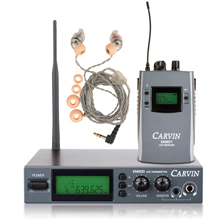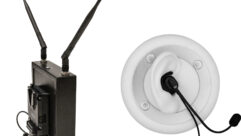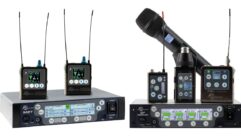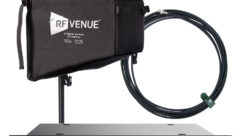

Carvin EM900 In-ear Monitor Review
May 11, 2012 4:41 PM,
Reviewer: John McJunkin
A system with impressive fidelity and lots of value.
Since time immemorial, bean counters and managers, constantly concerned with value and price, have wanted the best bang for the buck in terms of all the technology us techies use. This includes in-ear monitor systems (IEM). And aside from all the usual objections to wholesale adoption of IEMs, the big question from the money and management people is, “What do we gain by making the change and can we do so at a reasonable price?” High-end systems will scare off the slow-to-adopt based on price alone. And there are also valid concerns over the quality of inexpensive systems. Is there a product out there that delivers quality results at a reasonable price? The answer is yes, and the product is Carvin’s EM900 IEM system.
In the process of chitchatting with other live sound professionals, we talk brand names, model numbers, features, prices, and experiences, and opinions begin to formulate. We tend to hear the same brands and models over and over again, but I was frankly surprised that Carvin kept coming up in the IEM domain. Carvin is a company that is well known for its low prices, but the company never struck me as rising into the same domain as the other big IEM heavy hitters. But I kept hearing that name. In particular, my business partner uses the EM900 series in his weekly house of worship gig. In this church, there is no skimping on technology; the church employs an Avid Venue D-Show console, and high-end speakers, amps, processing, and mics abound. Why a bargain-brand IEM system? I soon found out.
The EM900 system consists of an EM901 beltpack receiver, an EM900 transmitter, and a pair of EM902 earbuds. The receiver is simple: antenna, level knob, pan pot, and output jack on top. On the front is the unit’s LCD alphanumeric display and navigation buttons. At bottom is the battery compartment cover. The receiver uses two AA batteries, a huge advantage over systems that use proprietary batteries. Even if proprietary batteries are rechargeable, if they go missing or malfunction for any reason, the system is down without the prospect of easily replaced batteries. I’m thrilled with the recent trend toward systems using standard, readily available batteries.
The EM900 transmitter is a 1RU half-rack space enclosure with a straightforward front panel. From left to right, you’ll find the power button, LCD alphanumeric display, navigation buttons, and level knobs for both the transmitted signal and the monitor jacks, also located on the front panel. The power button is a hold-down-for-a-moment type, preventing accidental power-downs. I also really like the fact that there are both 1/4in. and 1/8in. monitor jacks, so a monitor engineer can plug in with whatever he or she has available—from earbuds to full-size headphones. I plug in to monitor various signals in different locations every single day, and I can’t tell you how many times I have scrambled trying to find an adapter 30 seconds before air time. One minor complaint about the front panel is that the two level knobs are squat in shape, and are placed a little too closely together in my opinion. If they were a bit narrower in diameter and higher in profile, the placement would be appropriate, but as is, it’s a bit of a challenge to adjust one without bumping the other. The EM900 rear panel is simple: from left to right are an IEC power inlet, 1/4in. loop output jacks for channels 1 and 2, and balanced XLR 1/4in. inputs for channels 1 and 2, followed by a BNC antenna jack. I’m very pleased with the IEC AC power inlet; many other IEM systems similar to this use wall warts, which tend to test my patience.
Both the EM series receiver and transmitter are solidly built, constructed completely of metal (with the obvious exceptions of where plastic is necessary—displays, buttons, etc.). The receiver has rubberized grips on each side, making it easy to grasp sliding it on or off one’s belt or waistband. Looking these devices over, the pricing of the system starts to seem a little incongruous with its feel and appearance. The street price of this system is $349—about half the price of some comparable competitors’ systems, and it just feels every bit as rock solid and well constructed as its counterparts that cost twice as much.
The EM902 earbuds feature high-quality braided cabling, and are a highlight of this system in my estimation. I have fought and struggled with numerous earbuds from numerous manufacturers, and have never found one that truly thrilled me until now. The EM902 bud fits the ear comfortably, so much so that not only does it not cause fatigue, but also it is soon forgotten. It ships with three different size rubber “gaskets” to fit an ear canal of any size. The cables disappear over the top of the ear and down the back of the user’s shirt. A bolo-tie type slider allows the pair of cables to be drawn together closer to the earbuds to help keep the cabling out of view of the audience. The drivers in the earbuds are very impressive. I was very happy with the rich, full low end delivered by these buds. I will admit that I found the high end a little hypey, maybe even verging on splatty, but the receiver has a high-end boost circuit, which when switched off, mellows that issue out a bit. For that matter, a little EQ on the transmitter end of the system really allowed me to get excellent fidelity from the buds, and the SPL was more than sufficient.
Carvin EM900 In-ear Monitor Review
May 11, 2012 4:41 PM,
Reviewer: John McJunkin
A system with impressive fidelity and lots of value.
The system can operate in mono or stereo, pleasing picky musicians or speakers who want a stereophonic high-fidelity experience. In monophonic mode, the user can balance between the two input channels to achieve a “more me” mode, balancing for instance their own vocal with a complete mix-minus of the band. This strikes me as a pretty sophisticated feature for a system of this price. As many as 16 different transmitter frequencies can be used simultaneously, facilitating up to 16 distinct monitor mixes on stage at any given time. Of course, there is no limit to how many receivers can be set to receive each transmitter’s signal.
The overall frequency response of the system is 30Hz-15kHz, which, while it does not cover the entire audible spectrum of 20Hz-20kHz, is certainly sufficient. No earbuds in the world can reproduce 30Hz in a meaningful way, and for monitoring purposes 15kHz is a perfectly acceptable upper limit. The receiver has a limiter available, and I’m very pleased that it can be switched off at the whim of the user. I have used systems twice this price that don’t have that capacity. The RF section of the system employs a phase-locked loop that largely eliminates static and does not require a squelch knob (or the expertise to adjust one). Nine hundred sixty discreet frequencies are available, and in an obvious cost-cutting measure, there is absolutely no automation of frequency seeking whatsoever; it’s left to the engineer. But in my estimation, it’s a feature that makes sense to eliminate to arrive at such a low price. And considering the number of frequencies available, it’s not difficult to find one that’s open and unused over the 638-662MHz range. The backlit LCD displays on both transmitter and receiver are more than adequate and easy to read. I very much like the low battery indicator in the receiver’s display.
I monitored a pretty broad array of music and speech with this system, and I was truly impressed with the fidelity. The noise floor was low, and there was little distortion at nominal levels. Of course, nearing maximum SPL for the system, some distortion was present, but reducing level even just a bit largely eliminated it. The low end is truly impressive, and despite the slight brashness of the high end, I was able to sculpt the signal a bit with EQ and arrive at a clean, clear signal that truly sounded good.
I will go out on a limb and say that the Carvin EM900 is far and away the best value I’ve ever seen in an IEM system. Unless higher degrees of sophistication are absolutely necessary or unique RF specifications are required, I strongly recommend considering this system. This is the best bang for the buck I’ve ever seen in an IEM.
Product Summary
Pros: Inexpensive, surprisingly good quality, capacity for “more me” mixing
Cons: Transmitter knobs too close together
Applications: Any common IEM application, typically stage performance
Price: $399 (receiver, bodypack, earbuds)
Specifications:
System Specs:
Frequency response: 30Hz-15kHz (-3dB)
Frequency band: 638-662MHz
S/N ratio: 80dB (A-weighted)
Image frequency rejection: 80dB
Channel separation: 35dB
Input level switch: 0dB/-10dB XLR – 1/4in. inputs
AC input: 100-240V (switch-mode supply)
Receiver power: 2 AA batteries
Battery life: 12 hours (approx.)
Net weight: EM900 base: 3.2lbs. (1.45kg); EM901 receiver: 0.45lbs. (0.2kg)
Dimensions (HxWxD): EM900 base: 1.75”x8.35”x 9” (10.30” deep w/antenna & AC cord); EM901 receiver: 4.5”x2.75”x1”(without belt clip)
EM902 earphone specs:
Frequency response: 10Hz-20kHz
Transducer type: Dynamic
Impedance: 16Ω
Sensitivity @ 1kHz: 114dB/mW
Distortion: <0.3%
Weight: 11oz.
John McJunkin is the principal of Avalon Podcasting in Chandler, Ariz. He has consulted in the development of studios and installations and provides high-quality podcast-production services.










